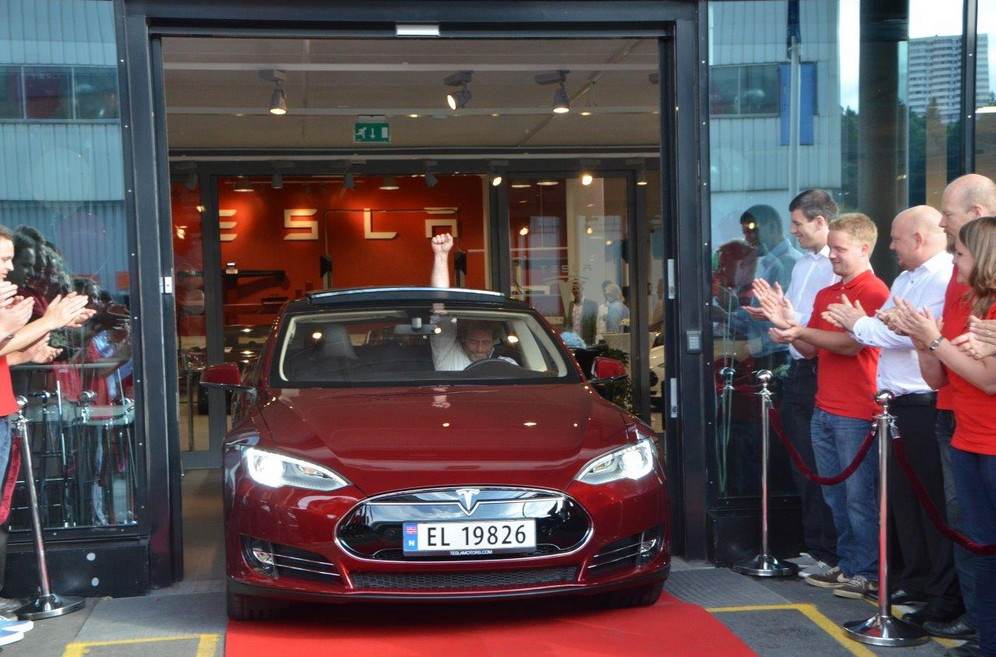March saw the sale of 1,521 Tesla Model S sedan-type electric automobiles in Norway, making it the most popular model of any car ever to be sold over the course of a month in this Scandinavian country.
March saw the sale of 1,521 Tesla Model S sedan-type electric automobiles in Norway, making it the most popular model of any car ever to be sold over the course of a month in this Scandinavian country.
“I don’t often entertain myself with car sale statistics, but this is one I will read as a bedtime story for children,” said Bellona President and Tesla enthusiast Frederic Hauge.
Hauge last month completed the first known trip in an electric car from Norway to Russia, driving the Tesla Model S across the Kola Peninsula from Kirkenes, Norway to Murmansk, part of the celebration surrounding the 20-year anniversary of Bellona’s Murmansk offices.
“At Bellona, we have been working for this since we imported Norway’s first electric vehicle in 1988,” said Hauge today. “Now we can finally celebrate – Norway is in the process of writing political climate history with our contribution to electric car breakthroughs. Politicians must be courageous and not weaken benefits bestowed on owners of electric cars, and must continue on the electric car road.”
The figures posted by the Tesla Model S’s sales last month are twice those of its nearest competitor, the electric Volkswagen Golf. Number five on the list of e-cars sold in Norway is Nissans LEAF electric car, which moved 425 units in March. In tenth place was BMW’s i3, which moved 336 units.
Taken together, these figures constitute a 20.3 percent of all automobile sales in Norway last month.
From an environmental point of view, these are the best auto sales statistics ever posted by Norway, said Hauge, and the Tesla Model S has broken all records for sales in a single month, meaning auto sales in Norway in March will equate to the lowest emissions car sales rush ever.
Statistics also show that had the electric car boom not been so impressive, Norway would not be on track to reach its climate target of 85 g/kilometer of emissions by 2020. Diesel and petrol powered vehicles’ emissions will subsequently fall to 2 g and 3 g per kilometer respectively.
“This shows that the technology shift that Tesla is responsible for is pushing us toward reaching our climate goals,” said Hauge. “Now it is critical that the government remain steady-handed and continue down the electric car track.”
The Norwegian government has promised in a statement to continue tax benefit to electric car owners through 2017. An agreement struck between the parliament’s Liberal Party and Christian Democratic Party says the climate deal will be reinforced. Meanwhile, Norway must reach some 8 million tons in overall emissions reductions to achieve the goals set by its climate agreement.
“We are in a bad way when in light of reaching the target in the climate agreement,” said Hauge. “ To amplify the climate agreement, as the government promises, it is important it not chicken out of facilitating electric vehicle incentives, and to continue with the current policy package.”
“Now we have the means to produce results,” Hauge continued. “Then we let them continue to work – that’s the whole point of having these means available.”
On Monday, the UN’s Intergovernmental Panel on Climate Change (IPCC) released its latest report, and it makes for discouraging reading regarding the consequences of global warming that are already visible, said Hauge.
“It was a touch reminder of where we are headed if we don’t address the challenges,” said Hauge. “ Today’s sales figures for electric cars show a definite hope toward reversing that trend.
Norwegian Climate and Environment Minister Tine Sundtoft said earlier yesterday that the development of electric car sales has been a deliberate policy. It remains to be seen how strong her resolve will remain in this area, said Hauge.




